Leading Change Report: Tesco Plc and Organisational Dynamics Analysis
VerifiedAdded on 2023/01/05
|18
|5863
|49
Report
AI Summary
This report delves into the complexities of understanding and leading change within organizations, using Tesco Plc as a primary example. It begins by comparing organizational examples to illustrate the impact of change on strategy and operations. The report then evaluates the internal and external drivers of change, assessing their effects on leadership, team dynamics, and individual behaviors. Furthermore, it examines strategies to mitigate the negative impacts of change on organizational behavior. The analysis extends to identifying and explaining various barriers to change and their influence on leadership decision-making. Finally, the report explores different leadership approaches to address change across diverse organizational contexts, offering valuable insights into effective change management practices.
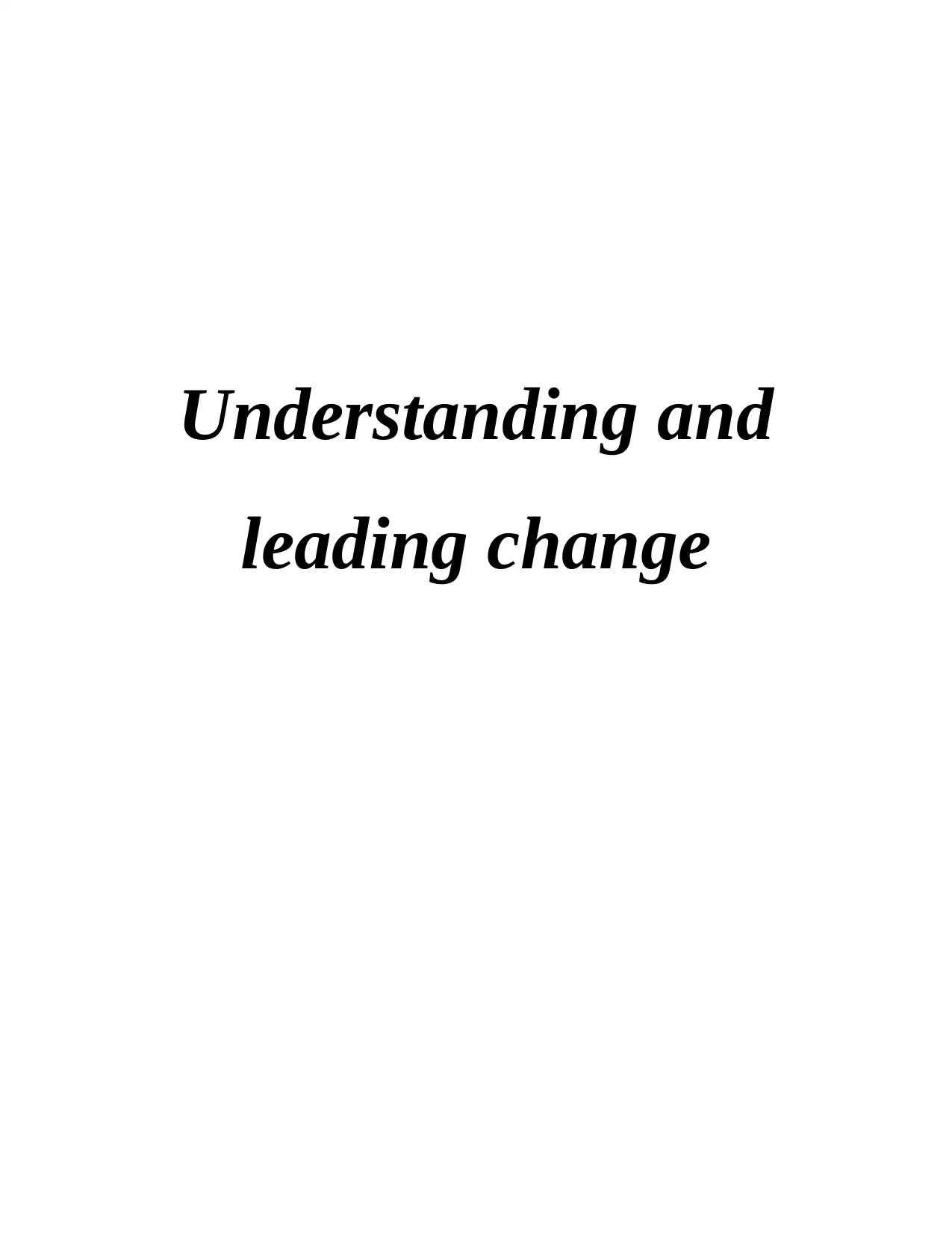
Understanding and
leading change
leading change
Paraphrase This Document
Need a fresh take? Get an instant paraphrase of this document with our AI Paraphraser

Table of Contents
INTRODUCTION...........................................................................................................................1
TASK1.............................................................................................................................................1
P1.Compare various organisational examples which have impact of change on organisational
strategy and operations................................................................................................................1
TASK2.............................................................................................................................................4
P2.Evaluate ways in internal and external drivers of change which affect leadership, team and
individual behaviours in organisation.........................................................................................4
P3.Evaluate measures that can be take to minimise negative impact of change in
organisational behaviour.............................................................................................................7
TASK3.............................................................................................................................................8
P4) Explain different barriers for change and determine how they influence leadership
decision-making:.........................................................................................................................8
TASK4...........................................................................................................................................11
P5) Different leadership approaches to deal with change in range of organisational context.. 11
CONCLUSION..............................................................................................................................13
.......................................................................................................................................................13
REFERENCES..............................................................................................................................14
INTRODUCTION...........................................................................................................................1
TASK1.............................................................................................................................................1
P1.Compare various organisational examples which have impact of change on organisational
strategy and operations................................................................................................................1
TASK2.............................................................................................................................................4
P2.Evaluate ways in internal and external drivers of change which affect leadership, team and
individual behaviours in organisation.........................................................................................4
P3.Evaluate measures that can be take to minimise negative impact of change in
organisational behaviour.............................................................................................................7
TASK3.............................................................................................................................................8
P4) Explain different barriers for change and determine how they influence leadership
decision-making:.........................................................................................................................8
TASK4...........................................................................................................................................11
P5) Different leadership approaches to deal with change in range of organisational context.. 11
CONCLUSION..............................................................................................................................13
.......................................................................................................................................................13
REFERENCES..............................................................................................................................14
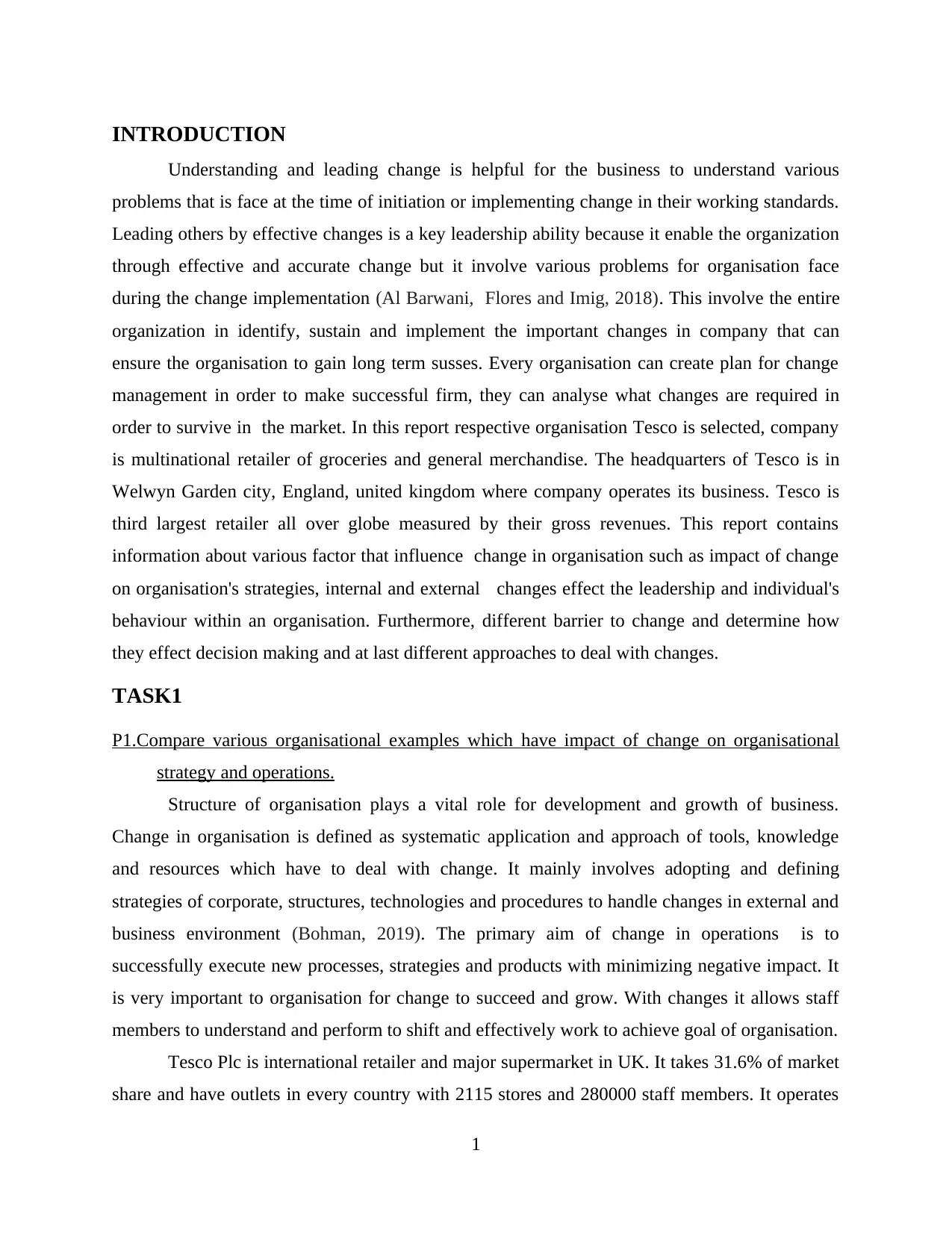
INTRODUCTION
Understanding and leading change is helpful for the business to understand various
problems that is face at the time of initiation or implementing change in their working standards.
Leading others by effective changes is a key leadership ability because it enable the organization
through effective and accurate change but it involve various problems for organisation face
during the change implementation (Al Barwani, Flores and Imig, 2018). This involve the entire
organization in identify, sustain and implement the important changes in company that can
ensure the organisation to gain long term susses. Every organisation can create plan for change
management in order to make successful firm, they can analyse what changes are required in
order to survive in the market. In this report respective organisation Tesco is selected, company
is multinational retailer of groceries and general merchandise. The headquarters of Tesco is in
Welwyn Garden city, England, united kingdom where company operates its business. Tesco is
third largest retailer all over globe measured by their gross revenues. This report contains
information about various factor that influence change in organisation such as impact of change
on organisation's strategies, internal and external changes effect the leadership and individual's
behaviour within an organisation. Furthermore, different barrier to change and determine how
they effect decision making and at last different approaches to deal with changes.
TASK1
P1.Compare various organisational examples which have impact of change on organisational
strategy and operations.
Structure of organisation plays a vital role for development and growth of business.
Change in organisation is defined as systematic application and approach of tools, knowledge
and resources which have to deal with change. It mainly involves adopting and defining
strategies of corporate, structures, technologies and procedures to handle changes in external and
business environment (Bohman, 2019). The primary aim of change in operations is to
successfully execute new processes, strategies and products with minimizing negative impact. It
is very important to organisation for change to succeed and grow. With changes it allows staff
members to understand and perform to shift and effectively work to achieve goal of organisation.
Tesco Plc is international retailer and major supermarket in UK. It takes 31.6% of market
share and have outlets in every country with 2115 stores and 280000 staff members. It operates
1
Understanding and leading change is helpful for the business to understand various
problems that is face at the time of initiation or implementing change in their working standards.
Leading others by effective changes is a key leadership ability because it enable the organization
through effective and accurate change but it involve various problems for organisation face
during the change implementation (Al Barwani, Flores and Imig, 2018). This involve the entire
organization in identify, sustain and implement the important changes in company that can
ensure the organisation to gain long term susses. Every organisation can create plan for change
management in order to make successful firm, they can analyse what changes are required in
order to survive in the market. In this report respective organisation Tesco is selected, company
is multinational retailer of groceries and general merchandise. The headquarters of Tesco is in
Welwyn Garden city, England, united kingdom where company operates its business. Tesco is
third largest retailer all over globe measured by their gross revenues. This report contains
information about various factor that influence change in organisation such as impact of change
on organisation's strategies, internal and external changes effect the leadership and individual's
behaviour within an organisation. Furthermore, different barrier to change and determine how
they effect decision making and at last different approaches to deal with changes.
TASK1
P1.Compare various organisational examples which have impact of change on organisational
strategy and operations.
Structure of organisation plays a vital role for development and growth of business.
Change in organisation is defined as systematic application and approach of tools, knowledge
and resources which have to deal with change. It mainly involves adopting and defining
strategies of corporate, structures, technologies and procedures to handle changes in external and
business environment (Bohman, 2019). The primary aim of change in operations is to
successfully execute new processes, strategies and products with minimizing negative impact. It
is very important to organisation for change to succeed and grow. With changes it allows staff
members to understand and perform to shift and effectively work to achieve goal of organisation.
Tesco Plc is international retailer and major supermarket in UK. It takes 31.6% of market
share and have outlets in every country with 2115 stores and 280000 staff members. It operates
1
⊘ This is a preview!⊘
Do you want full access?
Subscribe today to unlock all pages.

Trusted by 1+ million students worldwide
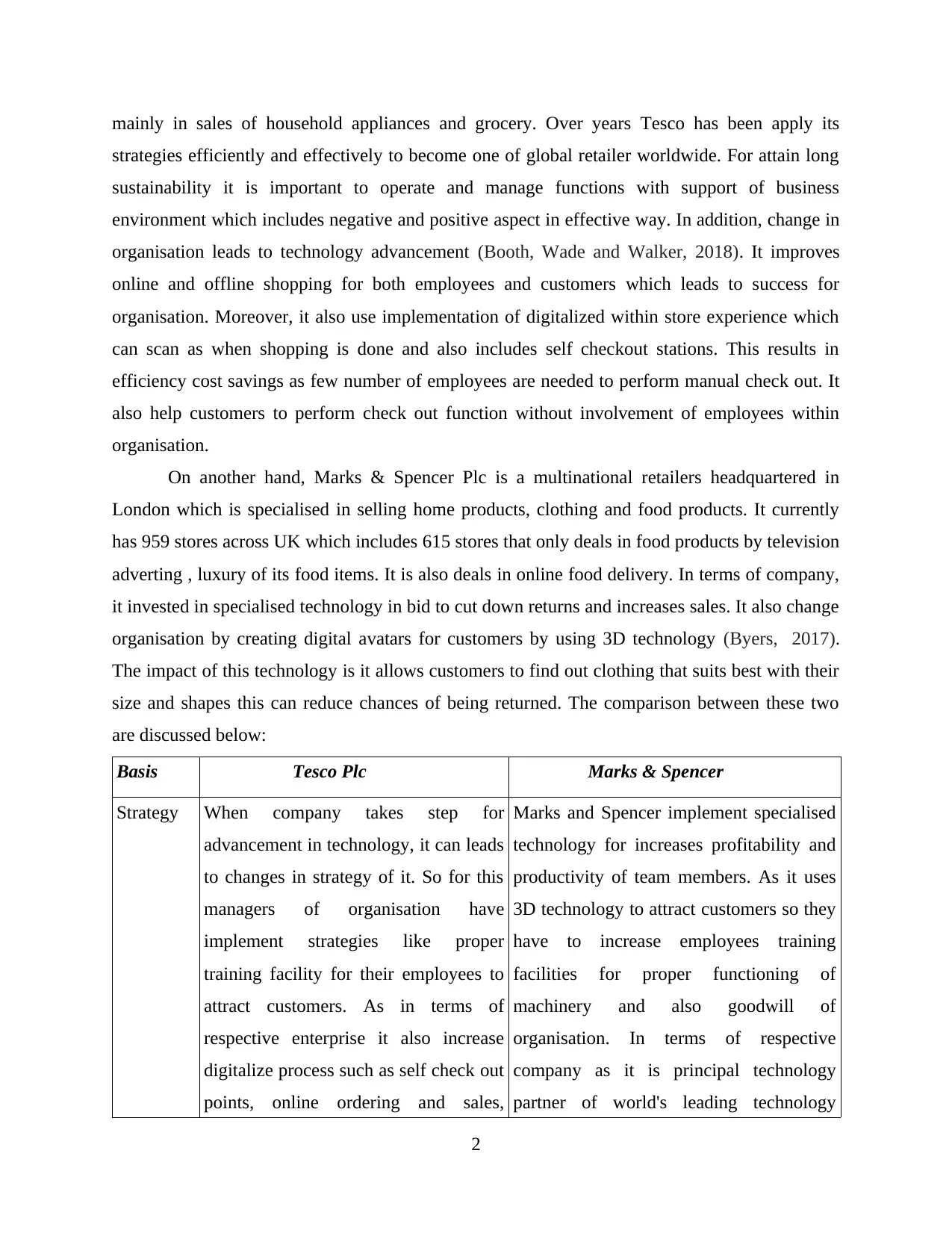
mainly in sales of household appliances and grocery. Over years Tesco has been apply its
strategies efficiently and effectively to become one of global retailer worldwide. For attain long
sustainability it is important to operate and manage functions with support of business
environment which includes negative and positive aspect in effective way. In addition, change in
organisation leads to technology advancement (Booth, Wade and Walker, 2018). It improves
online and offline shopping for both employees and customers which leads to success for
organisation. Moreover, it also use implementation of digitalized within store experience which
can scan as when shopping is done and also includes self checkout stations. This results in
efficiency cost savings as few number of employees are needed to perform manual check out. It
also help customers to perform check out function without involvement of employees within
organisation.
On another hand, Marks & Spencer Plc is a multinational retailers headquartered in
London which is specialised in selling home products, clothing and food products. It currently
has 959 stores across UK which includes 615 stores that only deals in food products by television
adverting , luxury of its food items. It is also deals in online food delivery. In terms of company,
it invested in specialised technology in bid to cut down returns and increases sales. It also change
organisation by creating digital avatars for customers by using 3D technology (Byers, 2017).
The impact of this technology is it allows customers to find out clothing that suits best with their
size and shapes this can reduce chances of being returned. The comparison between these two
are discussed below:
Basis Tesco Plc Marks & Spencer
Strategy When company takes step for
advancement in technology, it can leads
to changes in strategy of it. So for this
managers of organisation have
implement strategies like proper
training facility for their employees to
attract customers. As in terms of
respective enterprise it also increase
digitalize process such as self check out
points, online ordering and sales,
Marks and Spencer implement specialised
technology for increases profitability and
productivity of team members. As it uses
3D technology to attract customers so they
have to increase employees training
facilities for proper functioning of
machinery and also goodwill of
organisation. In terms of respective
company as it is principal technology
partner of world's leading technology
2
strategies efficiently and effectively to become one of global retailer worldwide. For attain long
sustainability it is important to operate and manage functions with support of business
environment which includes negative and positive aspect in effective way. In addition, change in
organisation leads to technology advancement (Booth, Wade and Walker, 2018). It improves
online and offline shopping for both employees and customers which leads to success for
organisation. Moreover, it also use implementation of digitalized within store experience which
can scan as when shopping is done and also includes self checkout stations. This results in
efficiency cost savings as few number of employees are needed to perform manual check out. It
also help customers to perform check out function without involvement of employees within
organisation.
On another hand, Marks & Spencer Plc is a multinational retailers headquartered in
London which is specialised in selling home products, clothing and food products. It currently
has 959 stores across UK which includes 615 stores that only deals in food products by television
adverting , luxury of its food items. It is also deals in online food delivery. In terms of company,
it invested in specialised technology in bid to cut down returns and increases sales. It also change
organisation by creating digital avatars for customers by using 3D technology (Byers, 2017).
The impact of this technology is it allows customers to find out clothing that suits best with their
size and shapes this can reduce chances of being returned. The comparison between these two
are discussed below:
Basis Tesco Plc Marks & Spencer
Strategy When company takes step for
advancement in technology, it can leads
to changes in strategy of it. So for this
managers of organisation have
implement strategies like proper
training facility for their employees to
attract customers. As in terms of
respective enterprise it also increase
digitalize process such as self check out
points, online ordering and sales,
Marks and Spencer implement specialised
technology for increases profitability and
productivity of team members. As it uses
3D technology to attract customers so they
have to increase employees training
facilities for proper functioning of
machinery and also goodwill of
organisation. In terms of respective
company as it is principal technology
partner of world's leading technology
2
Paraphrase This Document
Need a fresh take? Get an instant paraphrase of this document with our AI Paraphraser
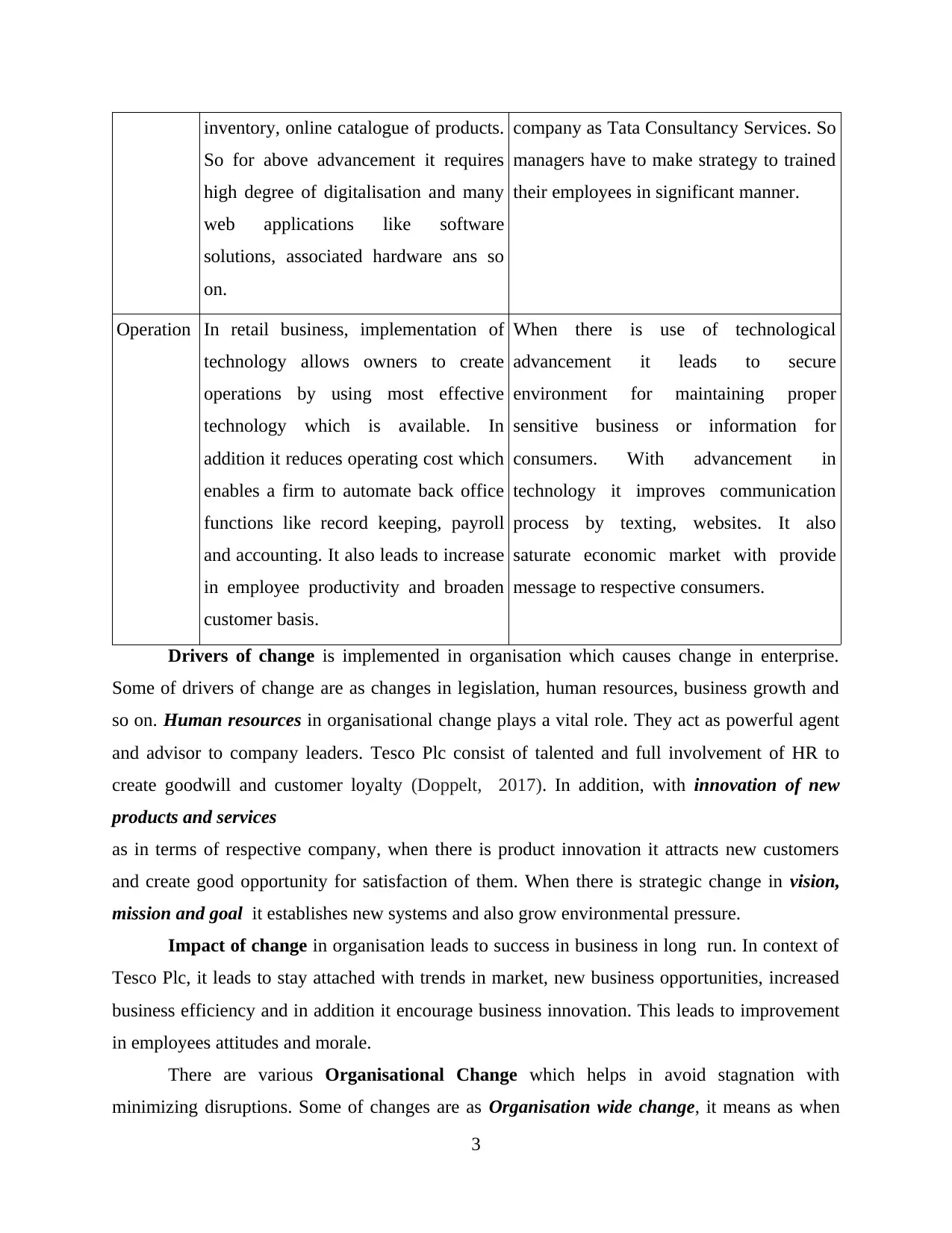
inventory, online catalogue of products.
So for above advancement it requires
high degree of digitalisation and many
web applications like software
solutions, associated hardware ans so
on.
company as Tata Consultancy Services. So
managers have to make strategy to trained
their employees in significant manner.
Operation In retail business, implementation of
technology allows owners to create
operations by using most effective
technology which is available. In
addition it reduces operating cost which
enables a firm to automate back office
functions like record keeping, payroll
and accounting. It also leads to increase
in employee productivity and broaden
customer basis.
When there is use of technological
advancement it leads to secure
environment for maintaining proper
sensitive business or information for
consumers. With advancement in
technology it improves communication
process by texting, websites. It also
saturate economic market with provide
message to respective consumers.
Drivers of change is implemented in organisation which causes change in enterprise.
Some of drivers of change are as changes in legislation, human resources, business growth and
so on. Human resources in organisational change plays a vital role. They act as powerful agent
and advisor to company leaders. Tesco Plc consist of talented and full involvement of HR to
create goodwill and customer loyalty (Doppelt, 2017). In addition, with innovation of new
products and services
as in terms of respective company, when there is product innovation it attracts new customers
and create good opportunity for satisfaction of them. When there is strategic change in vision,
mission and goal it establishes new systems and also grow environmental pressure.
Impact of change in organisation leads to success in business in long run. In context of
Tesco Plc, it leads to stay attached with trends in market, new business opportunities, increased
business efficiency and in addition it encourage business innovation. This leads to improvement
in employees attitudes and morale.
There are various Organisational Change which helps in avoid stagnation with
minimizing disruptions. Some of changes are as Organisation wide change, it means as when
3
So for above advancement it requires
high degree of digitalisation and many
web applications like software
solutions, associated hardware ans so
on.
company as Tata Consultancy Services. So
managers have to make strategy to trained
their employees in significant manner.
Operation In retail business, implementation of
technology allows owners to create
operations by using most effective
technology which is available. In
addition it reduces operating cost which
enables a firm to automate back office
functions like record keeping, payroll
and accounting. It also leads to increase
in employee productivity and broaden
customer basis.
When there is use of technological
advancement it leads to secure
environment for maintaining proper
sensitive business or information for
consumers. With advancement in
technology it improves communication
process by texting, websites. It also
saturate economic market with provide
message to respective consumers.
Drivers of change is implemented in organisation which causes change in enterprise.
Some of drivers of change are as changes in legislation, human resources, business growth and
so on. Human resources in organisational change plays a vital role. They act as powerful agent
and advisor to company leaders. Tesco Plc consist of talented and full involvement of HR to
create goodwill and customer loyalty (Doppelt, 2017). In addition, with innovation of new
products and services
as in terms of respective company, when there is product innovation it attracts new customers
and create good opportunity for satisfaction of them. When there is strategic change in vision,
mission and goal it establishes new systems and also grow environmental pressure.
Impact of change in organisation leads to success in business in long run. In context of
Tesco Plc, it leads to stay attached with trends in market, new business opportunities, increased
business efficiency and in addition it encourage business innovation. This leads to improvement
in employees attitudes and morale.
There are various Organisational Change which helps in avoid stagnation with
minimizing disruptions. Some of changes are as Organisation wide change, it means as when
3
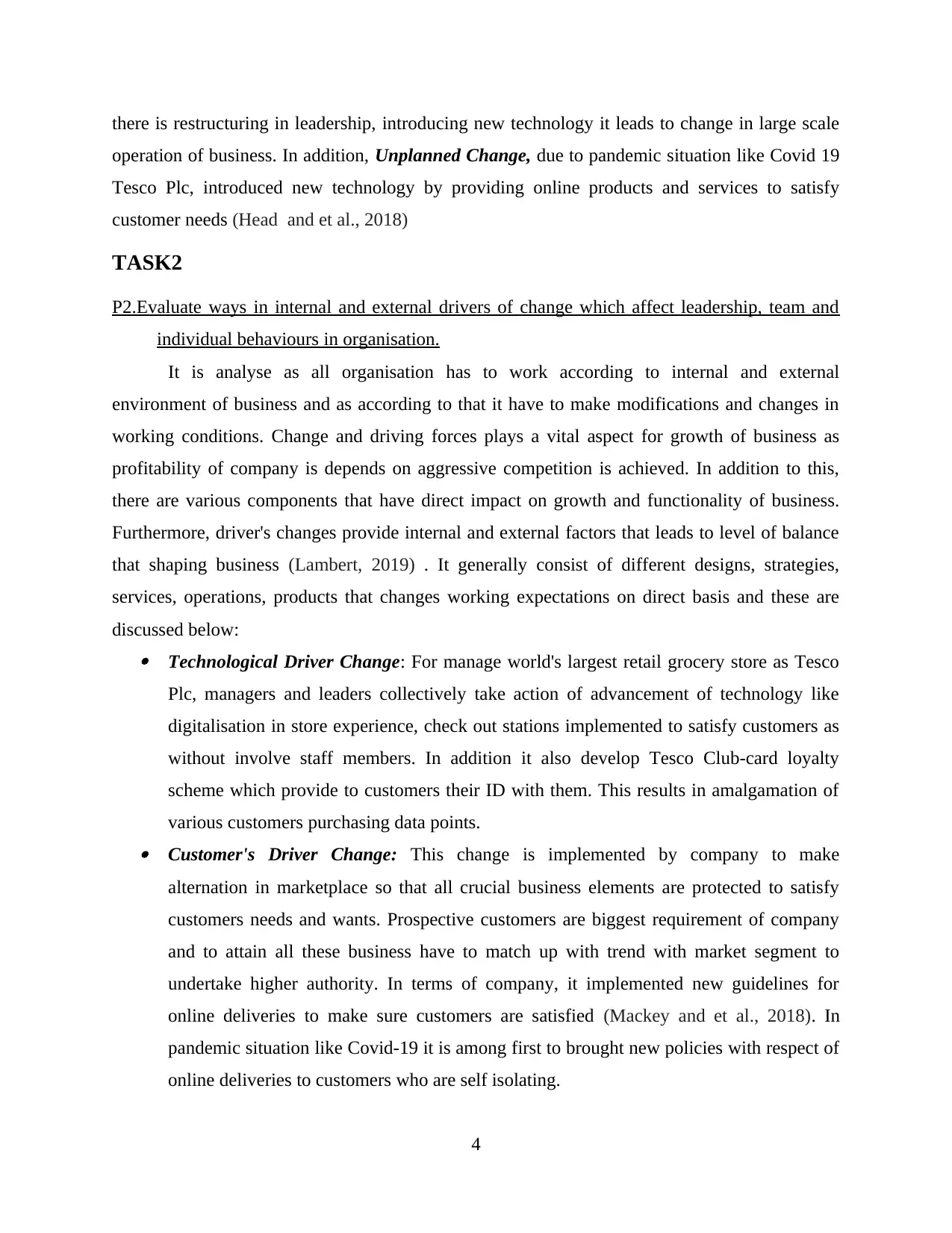
there is restructuring in leadership, introducing new technology it leads to change in large scale
operation of business. In addition, Unplanned Change, due to pandemic situation like Covid 19
Tesco Plc, introduced new technology by providing online products and services to satisfy
customer needs (Head and et al., 2018)
TASK2
P2.Evaluate ways in internal and external drivers of change which affect leadership, team and
individual behaviours in organisation.
It is analyse as all organisation has to work according to internal and external
environment of business and as according to that it have to make modifications and changes in
working conditions. Change and driving forces plays a vital aspect for growth of business as
profitability of company is depends on aggressive competition is achieved. In addition to this,
there are various components that have direct impact on growth and functionality of business.
Furthermore, driver's changes provide internal and external factors that leads to level of balance
that shaping business (Lambert, 2019) . It generally consist of different designs, strategies,
services, operations, products that changes working expectations on direct basis and these are
discussed below: Technological Driver Change: For manage world's largest retail grocery store as Tesco
Plc, managers and leaders collectively take action of advancement of technology like
digitalisation in store experience, check out stations implemented to satisfy customers as
without involve staff members. In addition it also develop Tesco Club-card loyalty
scheme which provide to customers their ID with them. This results in amalgamation of
various customers purchasing data points. Customer's Driver Change: This change is implemented by company to make
alternation in marketplace so that all crucial business elements are protected to satisfy
customers needs and wants. Prospective customers are biggest requirement of company
and to attain all these business have to match up with trend with market segment to
undertake higher authority. In terms of company, it implemented new guidelines for
online deliveries to make sure customers are satisfied (Mackey and et al., 2018). In
pandemic situation like Covid-19 it is among first to brought new policies with respect of
online deliveries to customers who are self isolating.
4
operation of business. In addition, Unplanned Change, due to pandemic situation like Covid 19
Tesco Plc, introduced new technology by providing online products and services to satisfy
customer needs (Head and et al., 2018)
TASK2
P2.Evaluate ways in internal and external drivers of change which affect leadership, team and
individual behaviours in organisation.
It is analyse as all organisation has to work according to internal and external
environment of business and as according to that it have to make modifications and changes in
working conditions. Change and driving forces plays a vital aspect for growth of business as
profitability of company is depends on aggressive competition is achieved. In addition to this,
there are various components that have direct impact on growth and functionality of business.
Furthermore, driver's changes provide internal and external factors that leads to level of balance
that shaping business (Lambert, 2019) . It generally consist of different designs, strategies,
services, operations, products that changes working expectations on direct basis and these are
discussed below: Technological Driver Change: For manage world's largest retail grocery store as Tesco
Plc, managers and leaders collectively take action of advancement of technology like
digitalisation in store experience, check out stations implemented to satisfy customers as
without involve staff members. In addition it also develop Tesco Club-card loyalty
scheme which provide to customers their ID with them. This results in amalgamation of
various customers purchasing data points. Customer's Driver Change: This change is implemented by company to make
alternation in marketplace so that all crucial business elements are protected to satisfy
customers needs and wants. Prospective customers are biggest requirement of company
and to attain all these business have to match up with trend with market segment to
undertake higher authority. In terms of company, it implemented new guidelines for
online deliveries to make sure customers are satisfied (Mackey and et al., 2018). In
pandemic situation like Covid-19 it is among first to brought new policies with respect of
online deliveries to customers who are self isolating.
4
⊘ This is a preview!⊘
Do you want full access?
Subscribe today to unlock all pages.

Trusted by 1+ million students worldwide
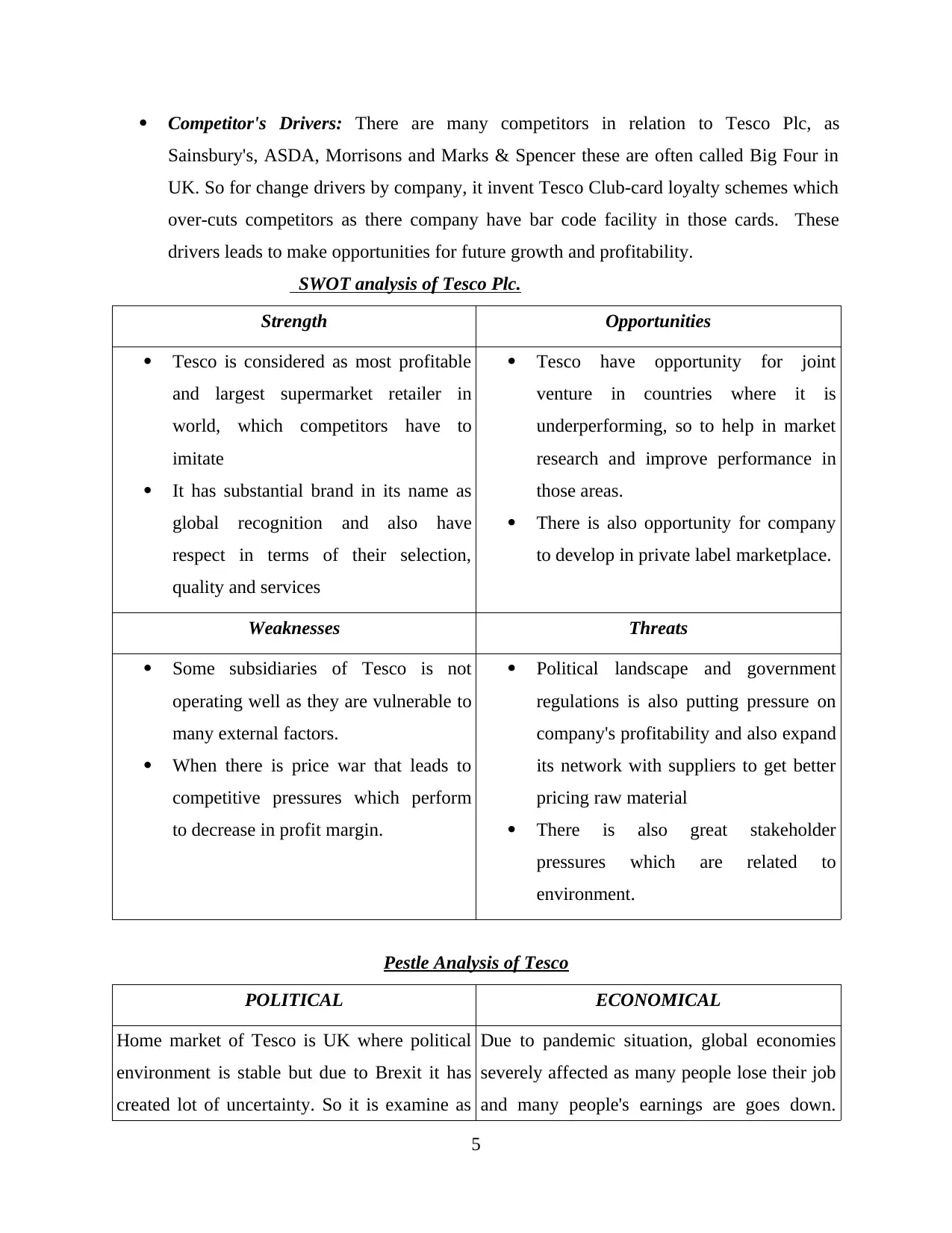
Competitor's Drivers: There are many competitors in relation to Tesco Plc, as
Sainsbury's, ASDA, Morrisons and Marks & Spencer these are often called Big Four in
UK. So for change drivers by company, it invent Tesco Club-card loyalty schemes which
over-cuts competitors as there company have bar code facility in those cards. These
drivers leads to make opportunities for future growth and profitability.
SWOT analysis of Tesco Plc.
Strength Opportunities
Tesco is considered as most profitable
and largest supermarket retailer in
world, which competitors have to
imitate
It has substantial brand in its name as
global recognition and also have
respect in terms of their selection,
quality and services
Tesco have opportunity for joint
venture in countries where it is
underperforming, so to help in market
research and improve performance in
those areas.
There is also opportunity for company
to develop in private label marketplace.
Weaknesses Threats
Some subsidiaries of Tesco is not
operating well as they are vulnerable to
many external factors.
When there is price war that leads to
competitive pressures which perform
to decrease in profit margin.
Political landscape and government
regulations is also putting pressure on
company's profitability and also expand
its network with suppliers to get better
pricing raw material
There is also great stakeholder
pressures which are related to
environment.
Pestle Analysis of Tesco
POLITICAL ECONOMICAL
Home market of Tesco is UK where political
environment is stable but due to Brexit it has
created lot of uncertainty. So it is examine as
Due to pandemic situation, global economies
severely affected as many people lose their job
and many people's earnings are goes down.
5
Sainsbury's, ASDA, Morrisons and Marks & Spencer these are often called Big Four in
UK. So for change drivers by company, it invent Tesco Club-card loyalty schemes which
over-cuts competitors as there company have bar code facility in those cards. These
drivers leads to make opportunities for future growth and profitability.
SWOT analysis of Tesco Plc.
Strength Opportunities
Tesco is considered as most profitable
and largest supermarket retailer in
world, which competitors have to
imitate
It has substantial brand in its name as
global recognition and also have
respect in terms of their selection,
quality and services
Tesco have opportunity for joint
venture in countries where it is
underperforming, so to help in market
research and improve performance in
those areas.
There is also opportunity for company
to develop in private label marketplace.
Weaknesses Threats
Some subsidiaries of Tesco is not
operating well as they are vulnerable to
many external factors.
When there is price war that leads to
competitive pressures which perform
to decrease in profit margin.
Political landscape and government
regulations is also putting pressure on
company's profitability and also expand
its network with suppliers to get better
pricing raw material
There is also great stakeholder
pressures which are related to
environment.
Pestle Analysis of Tesco
POLITICAL ECONOMICAL
Home market of Tesco is UK where political
environment is stable but due to Brexit it has
created lot of uncertainty. So it is examine as
Due to pandemic situation, global economies
severely affected as many people lose their job
and many people's earnings are goes down.
5
Paraphrase This Document
Need a fresh take? Get an instant paraphrase of this document with our AI Paraphraser
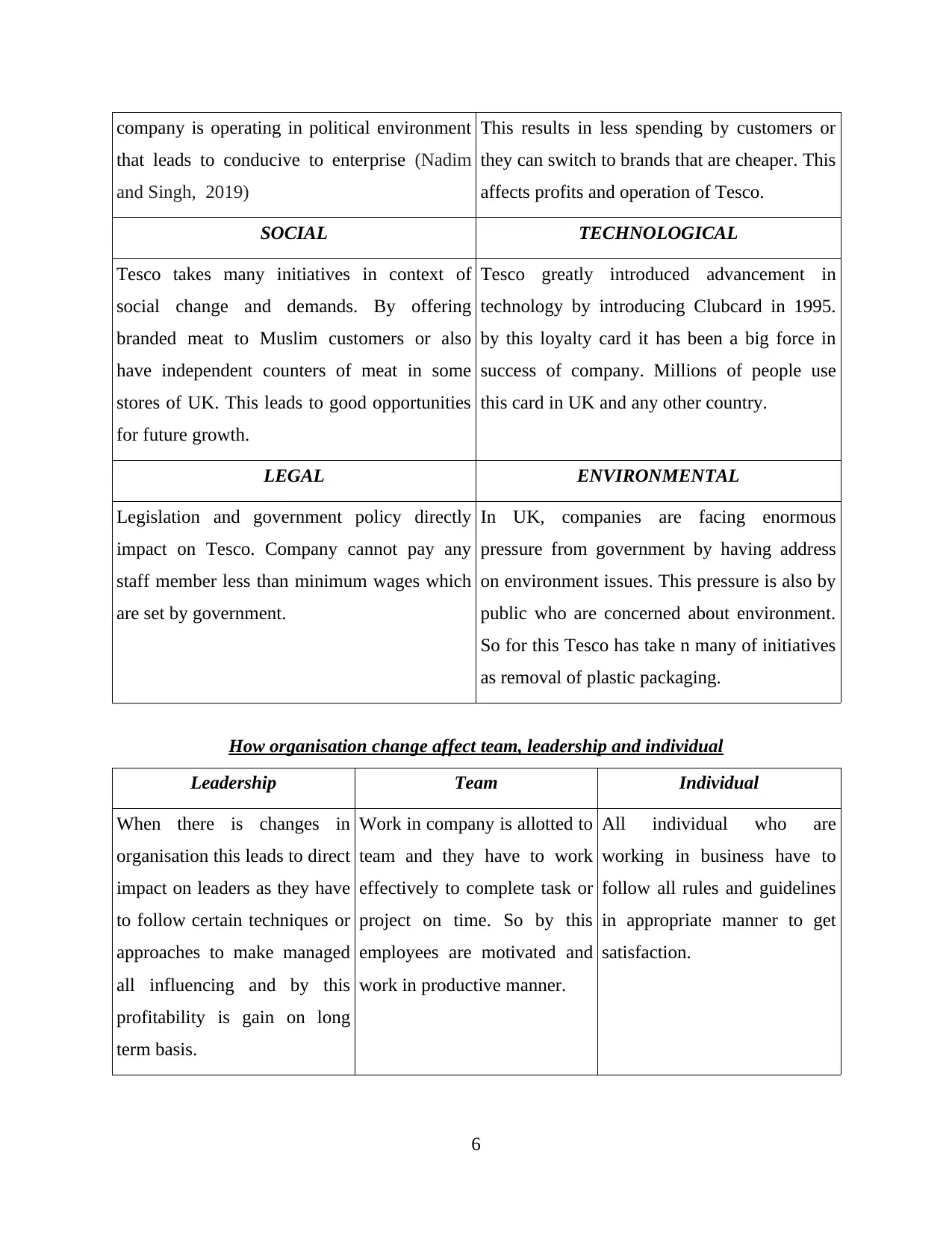
company is operating in political environment
that leads to conducive to enterprise (Nadim
and Singh, 2019)
This results in less spending by customers or
they can switch to brands that are cheaper. This
affects profits and operation of Tesco.
SOCIAL TECHNOLOGICAL
Tesco takes many initiatives in context of
social change and demands. By offering
branded meat to Muslim customers or also
have independent counters of meat in some
stores of UK. This leads to good opportunities
for future growth.
Tesco greatly introduced advancement in
technology by introducing Clubcard in 1995.
by this loyalty card it has been a big force in
success of company. Millions of people use
this card in UK and any other country.
LEGAL ENVIRONMENTAL
Legislation and government policy directly
impact on Tesco. Company cannot pay any
staff member less than minimum wages which
are set by government.
In UK, companies are facing enormous
pressure from government by having address
on environment issues. This pressure is also by
public who are concerned about environment.
So for this Tesco has take n many of initiatives
as removal of plastic packaging.
How organisation change affect team, leadership and individual
Leadership Team Individual
When there is changes in
organisation this leads to direct
impact on leaders as they have
to follow certain techniques or
approaches to make managed
all influencing and by this
profitability is gain on long
term basis.
Work in company is allotted to
team and they have to work
effectively to complete task or
project on time. So by this
employees are motivated and
work in productive manner.
All individual who are
working in business have to
follow all rules and guidelines
in appropriate manner to get
satisfaction.
6
that leads to conducive to enterprise (Nadim
and Singh, 2019)
This results in less spending by customers or
they can switch to brands that are cheaper. This
affects profits and operation of Tesco.
SOCIAL TECHNOLOGICAL
Tesco takes many initiatives in context of
social change and demands. By offering
branded meat to Muslim customers or also
have independent counters of meat in some
stores of UK. This leads to good opportunities
for future growth.
Tesco greatly introduced advancement in
technology by introducing Clubcard in 1995.
by this loyalty card it has been a big force in
success of company. Millions of people use
this card in UK and any other country.
LEGAL ENVIRONMENTAL
Legislation and government policy directly
impact on Tesco. Company cannot pay any
staff member less than minimum wages which
are set by government.
In UK, companies are facing enormous
pressure from government by having address
on environment issues. This pressure is also by
public who are concerned about environment.
So for this Tesco has take n many of initiatives
as removal of plastic packaging.
How organisation change affect team, leadership and individual
Leadership Team Individual
When there is changes in
organisation this leads to direct
impact on leaders as they have
to follow certain techniques or
approaches to make managed
all influencing and by this
profitability is gain on long
term basis.
Work in company is allotted to
team and they have to work
effectively to complete task or
project on time. So by this
employees are motivated and
work in productive manner.
All individual who are
working in business have to
follow all rules and guidelines
in appropriate manner to get
satisfaction.
6
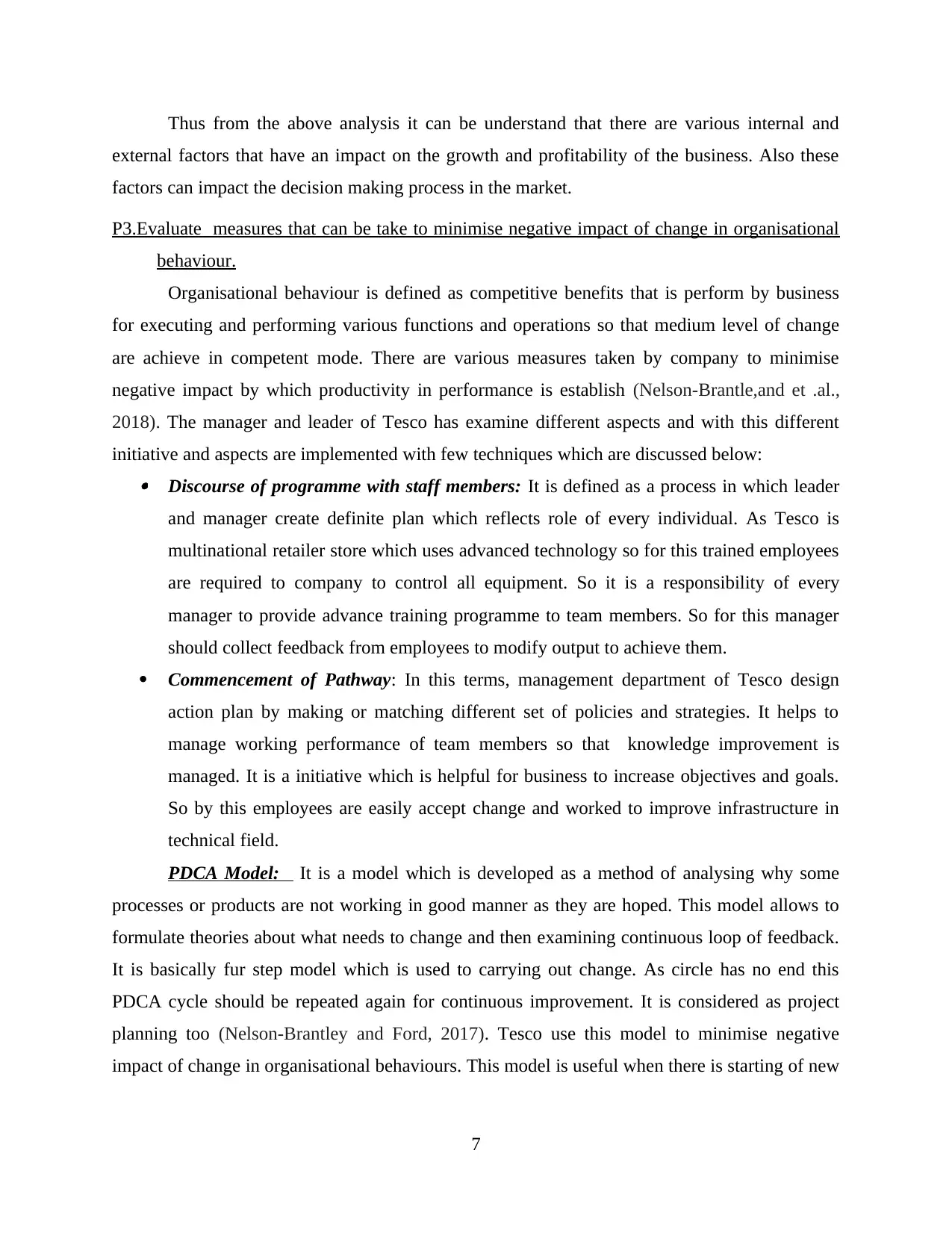
Thus from the above analysis it can be understand that there are various internal and
external factors that have an impact on the growth and profitability of the business. Also these
factors can impact the decision making process in the market.
P3.Evaluate measures that can be take to minimise negative impact of change in organisational
behaviour.
Organisational behaviour is defined as competitive benefits that is perform by business
for executing and performing various functions and operations so that medium level of change
are achieve in competent mode. There are various measures taken by company to minimise
negative impact by which productivity in performance is establish (Nelson-Brantle,and et .al.,
2018). The manager and leader of Tesco has examine different aspects and with this different
initiative and aspects are implemented with few techniques which are discussed below: Discourse of programme with staff members: It is defined as a process in which leader
and manager create definite plan which reflects role of every individual. As Tesco is
multinational retailer store which uses advanced technology so for this trained employees
are required to company to control all equipment. So it is a responsibility of every
manager to provide advance training programme to team members. So for this manager
should collect feedback from employees to modify output to achieve them.
Commencement of Pathway: In this terms, management department of Tesco design
action plan by making or matching different set of policies and strategies. It helps to
manage working performance of team members so that knowledge improvement is
managed. It is a initiative which is helpful for business to increase objectives and goals.
So by this employees are easily accept change and worked to improve infrastructure in
technical field.
PDCA Model: It is a model which is developed as a method of analysing why some
processes or products are not working in good manner as they are hoped. This model allows to
formulate theories about what needs to change and then examining continuous loop of feedback.
It is basically fur step model which is used to carrying out change. As circle has no end this
PDCA cycle should be repeated again for continuous improvement. It is considered as project
planning too (Nelson‐Brantley and Ford, 2017). Tesco use this model to minimise negative
impact of change in organisational behaviours. This model is useful when there is starting of new
7
external factors that have an impact on the growth and profitability of the business. Also these
factors can impact the decision making process in the market.
P3.Evaluate measures that can be take to minimise negative impact of change in organisational
behaviour.
Organisational behaviour is defined as competitive benefits that is perform by business
for executing and performing various functions and operations so that medium level of change
are achieve in competent mode. There are various measures taken by company to minimise
negative impact by which productivity in performance is establish (Nelson-Brantle,and et .al.,
2018). The manager and leader of Tesco has examine different aspects and with this different
initiative and aspects are implemented with few techniques which are discussed below: Discourse of programme with staff members: It is defined as a process in which leader
and manager create definite plan which reflects role of every individual. As Tesco is
multinational retailer store which uses advanced technology so for this trained employees
are required to company to control all equipment. So it is a responsibility of every
manager to provide advance training programme to team members. So for this manager
should collect feedback from employees to modify output to achieve them.
Commencement of Pathway: In this terms, management department of Tesco design
action plan by making or matching different set of policies and strategies. It helps to
manage working performance of team members so that knowledge improvement is
managed. It is a initiative which is helpful for business to increase objectives and goals.
So by this employees are easily accept change and worked to improve infrastructure in
technical field.
PDCA Model: It is a model which is developed as a method of analysing why some
processes or products are not working in good manner as they are hoped. This model allows to
formulate theories about what needs to change and then examining continuous loop of feedback.
It is basically fur step model which is used to carrying out change. As circle has no end this
PDCA cycle should be repeated again for continuous improvement. It is considered as project
planning too (Nelson‐Brantley and Ford, 2017). Tesco use this model to minimise negative
impact of change in organisational behaviours. This model is useful when there is starting of new
7
⊘ This is a preview!⊘
Do you want full access?
Subscribe today to unlock all pages.

Trusted by 1+ million students worldwide
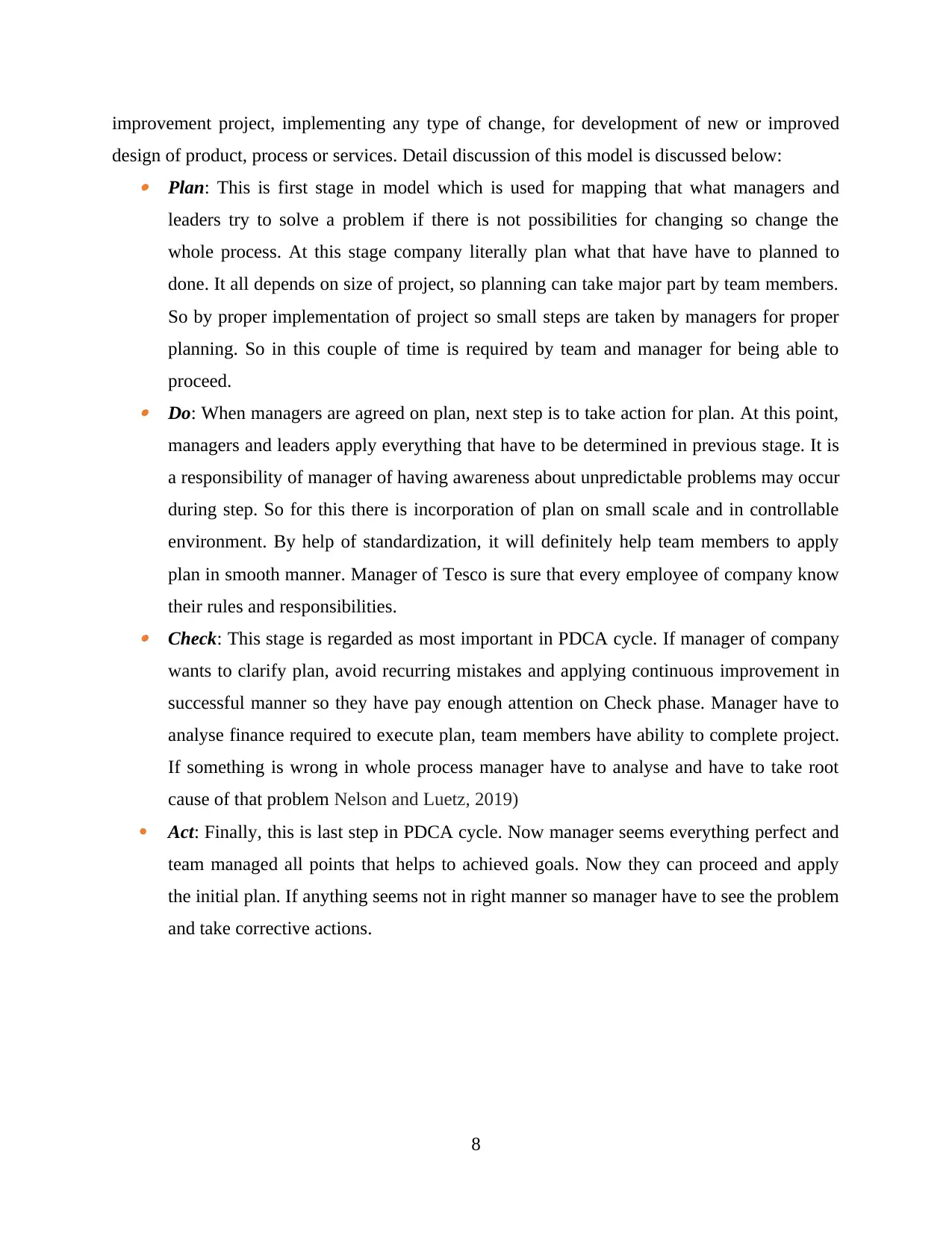
improvement project, implementing any type of change, for development of new or improved
design of product, process or services. Detail discussion of this model is discussed below: Plan: This is first stage in model which is used for mapping that what managers and
leaders try to solve a problem if there is not possibilities for changing so change the
whole process. At this stage company literally plan what that have have to planned to
done. It all depends on size of project, so planning can take major part by team members.
So by proper implementation of project so small steps are taken by managers for proper
planning. So in this couple of time is required by team and manager for being able to
proceed. Do: When managers are agreed on plan, next step is to take action for plan. At this point,
managers and leaders apply everything that have to be determined in previous stage. It is
a responsibility of manager of having awareness about unpredictable problems may occur
during step. So for this there is incorporation of plan on small scale and in controllable
environment. By help of standardization, it will definitely help team members to apply
plan in smooth manner. Manager of Tesco is sure that every employee of company know
their rules and responsibilities. Check: This stage is regarded as most important in PDCA cycle. If manager of company
wants to clarify plan, avoid recurring mistakes and applying continuous improvement in
successful manner so they have pay enough attention on Check phase. Manager have to
analyse finance required to execute plan, team members have ability to complete project.
If something is wrong in whole process manager have to analyse and have to take root
cause of that problem Nelson and Luetz, 2019)
Act: Finally, this is last step in PDCA cycle. Now manager seems everything perfect and
team managed all points that helps to achieved goals. Now they can proceed and apply
the initial plan. If anything seems not in right manner so manager have to see the problem
and take corrective actions.
8
design of product, process or services. Detail discussion of this model is discussed below: Plan: This is first stage in model which is used for mapping that what managers and
leaders try to solve a problem if there is not possibilities for changing so change the
whole process. At this stage company literally plan what that have have to planned to
done. It all depends on size of project, so planning can take major part by team members.
So by proper implementation of project so small steps are taken by managers for proper
planning. So in this couple of time is required by team and manager for being able to
proceed. Do: When managers are agreed on plan, next step is to take action for plan. At this point,
managers and leaders apply everything that have to be determined in previous stage. It is
a responsibility of manager of having awareness about unpredictable problems may occur
during step. So for this there is incorporation of plan on small scale and in controllable
environment. By help of standardization, it will definitely help team members to apply
plan in smooth manner. Manager of Tesco is sure that every employee of company know
their rules and responsibilities. Check: This stage is regarded as most important in PDCA cycle. If manager of company
wants to clarify plan, avoid recurring mistakes and applying continuous improvement in
successful manner so they have pay enough attention on Check phase. Manager have to
analyse finance required to execute plan, team members have ability to complete project.
If something is wrong in whole process manager have to analyse and have to take root
cause of that problem Nelson and Luetz, 2019)
Act: Finally, this is last step in PDCA cycle. Now manager seems everything perfect and
team managed all points that helps to achieved goals. Now they can proceed and apply
the initial plan. If anything seems not in right manner so manager have to see the problem
and take corrective actions.
8
Paraphrase This Document
Need a fresh take? Get an instant paraphrase of this document with our AI Paraphraser

TASK3
P4) Explain different barriers for change and determine how they influence leadership decision-
making:
The change is always brings in terms of modification by which positive amount of
changes are addressed in appropriate manner. In this ability of business to manage working
standards as by analysing various prospect is considerate. For this an organisation implement
various changes by which capability to attain long term sustainability in timely frame is
increases. Analysing different barrier to change in an organisation is helpful for the business to
create successful strategies for implantation and identification of change. It is very important
aspect for organisation and help in shifting to one stage to another for the profitability of
organisation. In the context of respective company Tesco, Below is the detail study of different
kind of change barriers that influence leadership decision making: Lack of employee involvement: This is the most conman barrier to change an
organisation face, every employee in organisation have fear to change, unless they are
getting involved in change process. It could effect the leader's decision making in Tesco
organization. Leaders of Tesco should involve their employees in change process so that
they can understand the changes and prepared themselves for that. Leaders should also
get the opinion of their employees so they can give their output to the organisation. Thus,
lack of involvement of employees can effect the leadership decision making of Tesco, but
organisation can deal with it by encouraging their employees to give suggestions and
opinion so that they do not fear to change. Organisational complexity: In every organisation, the stage comes when organisation
start to develop complexity in their environment. The process of organizing, planning,
managing and become more complex. In the complex environment it is quite difficult for
organisation to implant change. In the terms of Tesco, organisation also face complex
environment in their business. That also cause a barrier in the leadership decision making
process. Thus leader has work to reduce overall complexity and for this every task is
segmented into different slots but it sometime become hectic schedule. Tesco deal with
this barrier by improving the quality of their project and implementation of change in
effective way so they can achieve goals and targets.
9
P4) Explain different barriers for change and determine how they influence leadership decision-
making:
The change is always brings in terms of modification by which positive amount of
changes are addressed in appropriate manner. In this ability of business to manage working
standards as by analysing various prospect is considerate. For this an organisation implement
various changes by which capability to attain long term sustainability in timely frame is
increases. Analysing different barrier to change in an organisation is helpful for the business to
create successful strategies for implantation and identification of change. It is very important
aspect for organisation and help in shifting to one stage to another for the profitability of
organisation. In the context of respective company Tesco, Below is the detail study of different
kind of change barriers that influence leadership decision making: Lack of employee involvement: This is the most conman barrier to change an
organisation face, every employee in organisation have fear to change, unless they are
getting involved in change process. It could effect the leader's decision making in Tesco
organization. Leaders of Tesco should involve their employees in change process so that
they can understand the changes and prepared themselves for that. Leaders should also
get the opinion of their employees so they can give their output to the organisation. Thus,
lack of involvement of employees can effect the leadership decision making of Tesco, but
organisation can deal with it by encouraging their employees to give suggestions and
opinion so that they do not fear to change. Organisational complexity: In every organisation, the stage comes when organisation
start to develop complexity in their environment. The process of organizing, planning,
managing and become more complex. In the complex environment it is quite difficult for
organisation to implant change. In the terms of Tesco, organisation also face complex
environment in their business. That also cause a barrier in the leadership decision making
process. Thus leader has work to reduce overall complexity and for this every task is
segmented into different slots but it sometime become hectic schedule. Tesco deal with
this barrier by improving the quality of their project and implementation of change in
effective way so they can achieve goals and targets.
9

Unknown Current stage: Change is difficult for organisation if they do not know about
their current stage or status. They can not find problems within organisation if they don't
know about where their organisation is going. The organisation Tesco also could face this
barrier in their organisation. It is a stage that has generate and develop on random basis
and with this ability to connect with more of employee as by providing adequate
guidance and clarity is promoted. It is a barrier for leadership as in this leader has analyse
the overall working standards and have to make respect change as per suitability of
conditions are requirement (Nguyen and et .al., 2019) Thus working efficiency of leader
get affected continuously and with this productive amount of modification is induced by
making change.
Resistance for change- It is a factor that has resist an individual change so that workers
and employee's both get considerate. In this management of Tesco develop sustained
focus towards workforce change and its advancement. It is also be a barrier that resist
working performance and productivity of Tesco by which existing workers get
implement various changes on the basis of productive advancement. In this actual
change is analysed within which employee's and overall workforce manage its working
adequately. In this decision-making of leadership is affected as they leader has worked to
resist the change. For this leader analyse every condition and implement change as per
requirement in which ability to influence is affected over repetitive basis.
Force-field analysis: It is an analysis that is used to make suitable development within a
framework that is changes as on the basis of situational influence and overall condition of
business. It actually drives a movement by which helping and hindering forces is analysed and it
is as briefly explained below as:
Driving forces: These are the forces that is drive better change within the business so that
ability to gain productive changes is promoted over continuous period of time. There is few
driving forces and some are as defined below as: New technology: It is a change that promote working efficiency of business within which
management make sure that productive amount of changes is addressed with higher
suitability. In this better level of innovation and creativity is induced so that productive
amount of changes is addressed that is altered as per suitability of business and market
requirement.
10
their current stage or status. They can not find problems within organisation if they don't
know about where their organisation is going. The organisation Tesco also could face this
barrier in their organisation. It is a stage that has generate and develop on random basis
and with this ability to connect with more of employee as by providing adequate
guidance and clarity is promoted. It is a barrier for leadership as in this leader has analyse
the overall working standards and have to make respect change as per suitability of
conditions are requirement (Nguyen and et .al., 2019) Thus working efficiency of leader
get affected continuously and with this productive amount of modification is induced by
making change.
Resistance for change- It is a factor that has resist an individual change so that workers
and employee's both get considerate. In this management of Tesco develop sustained
focus towards workforce change and its advancement. It is also be a barrier that resist
working performance and productivity of Tesco by which existing workers get
implement various changes on the basis of productive advancement. In this actual
change is analysed within which employee's and overall workforce manage its working
adequately. In this decision-making of leadership is affected as they leader has worked to
resist the change. For this leader analyse every condition and implement change as per
requirement in which ability to influence is affected over repetitive basis.
Force-field analysis: It is an analysis that is used to make suitable development within a
framework that is changes as on the basis of situational influence and overall condition of
business. It actually drives a movement by which helping and hindering forces is analysed and it
is as briefly explained below as:
Driving forces: These are the forces that is drive better change within the business so that
ability to gain productive changes is promoted over continuous period of time. There is few
driving forces and some are as defined below as: New technology: It is a change that promote working efficiency of business within which
management make sure that productive amount of changes is addressed with higher
suitability. In this better level of innovation and creativity is induced so that productive
amount of changes is addressed that is altered as per suitability of business and market
requirement.
10
⊘ This is a preview!⊘
Do you want full access?
Subscribe today to unlock all pages.

Trusted by 1+ million students worldwide
1 out of 18
Related Documents
Your All-in-One AI-Powered Toolkit for Academic Success.
+13062052269
info@desklib.com
Available 24*7 on WhatsApp / Email
![[object Object]](/_next/static/media/star-bottom.7253800d.svg)
Unlock your academic potential
Copyright © 2020–2025 A2Z Services. All Rights Reserved. Developed and managed by ZUCOL.





